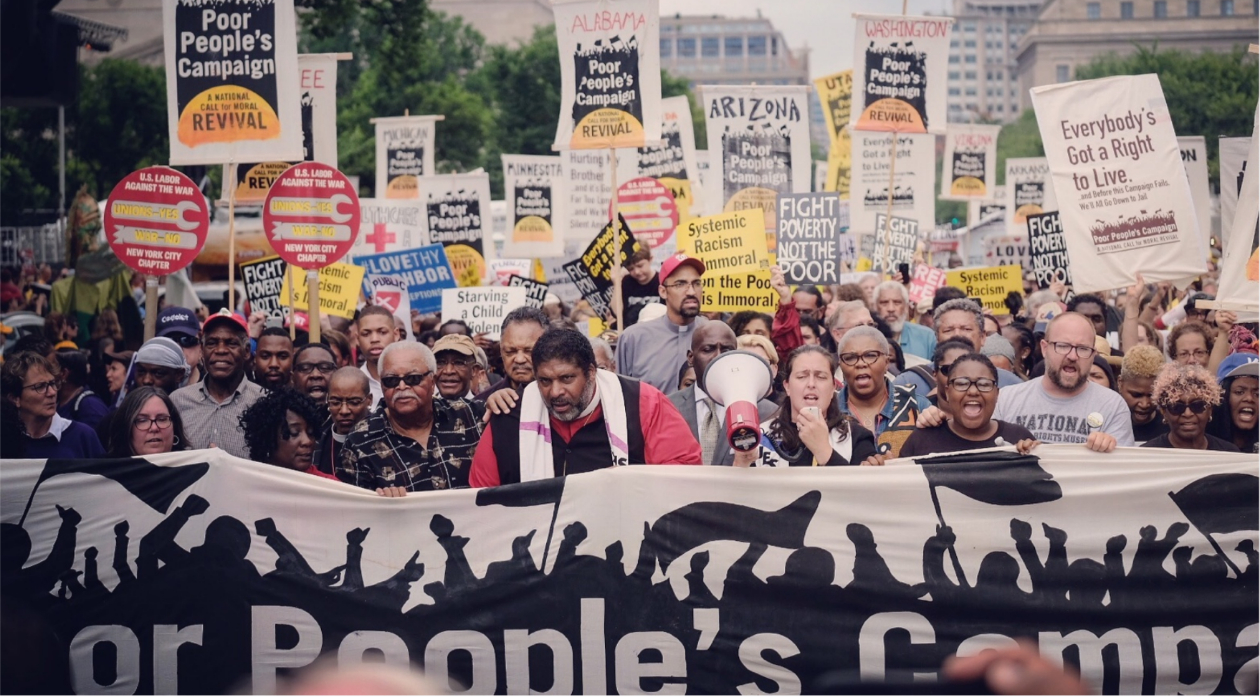
Tens of thousands are descending on Washington, D.C. for the historic, multiracial “Moral March on Washington and to the Polls.” The march occurs during the Juneteenth Holiday weekend and the growing battle to preserve and extend U.S. constitutional democracy.
The march, called by the Poor People’s Campaign, aims to mobilize the nation’s 140 million Black, Brown, and white poor and low-wage workers, and to unite, organize, and activate this potentially powerful force in coalition with others to remake U.S. society, the economy, and democracy from top to bottom.
Such a force could be decisive for the upcoming midterm elections. At stake is the people’s ability to shape the nation’s future for the benefit of all, our Constitutional democracy, the lives and rights of our people, and the existence of planet Earth.
Juneteenth celebrates the Emancipation of enslaved African Americans in 1863. This tradition of observance and celebration dates back to 1866 and is deeply rooted in African American culture and history.
The adoption of Juneteenth as a federal holiday by a Democratic majority Congress and president reflected the victory of a broad pro-democratic, multiracial, anti-racist coalition of forces that ousted the most openly racist administration in 100 years. It demonstrates the strength and level of African American equality and anti-racist movements to advance a multiracial democracy and is a dramatic validation of the premise that elections have consequences.
But the Moral March and Juneteenth celebration also occur against the backdrop of the ongoing attempted coup by Trump, his billionaire allies, the insurrectionist Republican Party, and the far-right and fascist movements so vividly captured during the nationally televised hearing of the January 6 Select Committee.
These forces are determined to achieve in 2022 and 2024 what they failed to accomplish in 2020. Their ascension to power would open the door to the complete rollback and likely violent repression of all democratic rights. They aim to restore unchallenged white supremacist minority rule, eliminate the peaceful transfer of power, and impose permanent governance by the fascist Republican Party.
The fight to mobilize the majority of Americans to isolate and defeat these forces to preserve and expand democracy is growing.
The Rev. William Barber III and Rev. Liz Theoharris, co-leaders of the Poor People’s Campaign and the June 18 march, are among those who view the current drive to defend and expand democratic rights as part of what is referred to as a Third Reconstruction in the U.S. They view it as a radical remaking of U.S. society, politics, and economy to benefit all.
Emancipation and the First Reconstruction
The First Radical Reconstruction era followed Emancipation, the second great American Revolution, and lasted from 1867 to 1876. Together, these two events marked the most significant advance for democracy in U.S. history. It was a recognition that the U.S. could never be fully democratic if African Americans were not entirely equal in every respect.
A multiracial coalition exercising federal political power, with the newly emancipated playing a leading role, drove the revolutionary social and economic reforms that ensued. The goal was to radically remake or reconstruct the nation from the grassroots to reflect its founding ideals, proclaimed on paper but not yet in practice.
During Reconstruction, Black political representation radically expanded. Over 600 African Americans were elected to state legislatures and Congress. New state constitutions were adopted in the former Confederate states proclaiming equality. The new state governments extended public education and distributed land and other economic resources to the emancipated. It was also an era of a general expansion of worker’s rights, and these advances favorably impacted the lives of white workers and their families, too.

Reconstruction Amendments to the U.S. Constitution accompanied legislative advances and were a codification of the expansion of democratic rights. The revolutionary 13th, 14th, and 15th Amendments abolished slavery and involuntary servitude (except in cases of incarceration), guaranteed citizenship, equal protection under the law, and voting rights (but only to men).
No sooner were these laws passed than the ruling forces comprising the old slavocracy began to mobilize to regain their power and reverse the revolutionary democratic gains. After only a decade, the old slavocracy defeated Reconstruction and the multiracial fusion coalition that won it.
From its beginnings, U.S. capitalism thrived on the exploitation of humanity, most brutally represented by the system of slavery. Despite the gains of Reconstruction, the systemic racism that was rooted in the capitalist system reasserted its power.
Employing open racial terror and racial division and allying with ruling elites nationally, the old slavocracy overthrew the Reconstruction governments. African Americans were disenfranchised and removed from political office, their newly accumulated wealth stolen or destroyed. The new state governments adopted Black codes to suppress African American rights and impose segregation and a brutal racial hierarchy.
The open racial terror and violent repression of African American rights, including lynch terror and imposition of Jim Crow segregation, lasted some 70 years and drove over six million African Americans to escape the sweltering oppression of the South during the Great Migration. Capitalism’s systemic racism ensured the existence and continuation of systemic poverty throughout the country in the decades that followed and right up through the present day.
Civil Rights Revolution and the Second Reconstruction
The mass Civil Rights movement crushed this fascist terror and broke the back of Jim Crow segregation. The Civil Rights Revolution, which many call the Second Reconstruction, resulted in landmark legal and legislative victories from Brown v. Board to civil, voting, and housing rights.
But the movement, rooted in the African American freedom struggle, came to reflect a broad multiracial movement for democracy. It helped spur historic democratic uprisings for the rights of Mexican Americans, Native Americans, women, LGBTQ people, immigrants, and disabled persons and for peace and the environment.
But the forces of white supremacy, the corporate ruling class, and reactionary elements never accepted this remaking of America and expansion of democratic rights, as incomplete as it was. Like the First Reconstruction, the Second Reconstruction also sparked a racist ruling class backlash. The result was a suppression of the movement, particularly the African American freedom movement, including the assassination of its leaders.
Central to this reactionary backlash was the rise of the new American extreme-right coalition backed by the most reactionary sectors of corporate America, which aims to dismantle the newly gained rights for equality. But its more significant aim is to impose white minority corporate rule and undo all social gains. These include worker and social rights won during the New Deal era, including union rights, Social Security, and other social progress. Just like the old slavocracy, they aim to destroy U.S. Constitutional democracy.

March for the Third Reconstruction
Our country’s multiracial working class and people have been in an epic battle with these reactionary forces since the 1980s. While the far-right and fascist movements and institutions, including right-wing mass media, have grown, so too have the mass movements for political and economic democracy.
Among the many gains recorded was the election of the nation’s first African American president, Barack Obama, whose campaign was based on fusion multiracial coalition politics. “Obama’s election represents the possibility of a Third Reconstruction,” Rev. Barber has said.
The new multiracial electorate that elected Obama, growing demographic changes, advances for racial, women’s, LGBTQ, and disability equality, and its growing unity and power scares corporate ruling forces and those influenced by white male supremacy and fear of societal change.
The backlash to these recent gains has been fierce and relentless, beginning with the Republican passage of voter suppression legislation across the South but now extending to the denial of abortion rights, attacks on union rights, and creating a public health crisis from the flood of guns in our streets.
Efforts to break up the multiracial electorate and roll back the rights of African Americans, Latinos, and other people of color and slow down and reverse the demographic shifts immediately followed Obama’s election victory. The far-right also mobilized against the rights of labor, women, immigrants, and the LGBTQ community.
The backlash gave rise to the MAGA fascist movement and ultimately the election of Trump, the imposition of an extreme-right-wing majority on the U.S. Supreme Court, and the passage of further voter suppression and election subversion laws to permanently institutionalize Republican rule.
But the mobilization of the forces to defeat Trump and defend U.S. Constitutional democracy has expanded the possibilities to expand democratic rights for a Third Radical Reconstruction. If mobilized, a democratic majority of Americans can exercise political power to address poverty and income disparity from the bottom up, address racial and gender inequality, avert the ecological and climate crises, and demilitarize the economy and society. “A Third Reconstruction to revive our moral and political commitment to democracy” is what must happen, says Rep. Barbara Lee.
U.S. capitalism, particularly its most reactionary sectors, is responsible for the massive economic, racial, and gender disparities that plague U.S. society and for the gun violence, militarization, and environmental threats that threaten life on this planet. As Rev. Barber noted, “Forty-three percent of people—over 140 million—live in poverty or are low income. 52% of our children live in poverty. And the Federal budget is just as immoral—$700 billion for defense and $700 billion for everything else. During COVID, billionaires made $2 trillion more and eight million more people fell into poverty. That’s ridiculous!”
The fight to end poverty, save the environment, demilitarize the economy, and defend and radically reform U.S. Constitutional democracy are all intertwined. A Third Reconstruction fulfills the hope of Juneteenth, the spirit of “Sí, se puede,” and the vision of “This land is your land, This land is our land.”
So wherever you are this Juneteenth weekend—whether it’s Washington, D.C., with the thousands of people mobilized by the Poor People’s Campaign, or in your own hometown—march for equality, justice, and democracy. And on Election Day, march again to the polls to cast your vote. March for the Third Reconstruction that our nation needs.










